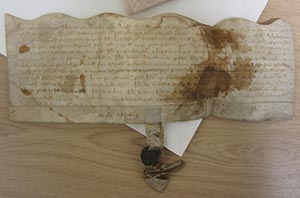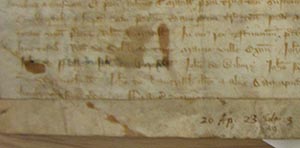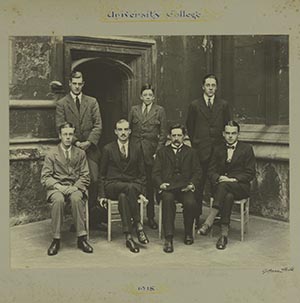Univ: plague & war part 1
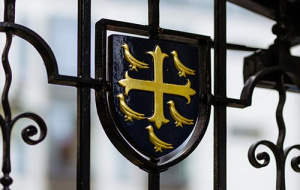 Part 1: plague and pandemic
Part 1: plague and pandemic
During these strange and difficult times, when the world is facing a pandemic unlike anything experienced in recent times, it is worth remembering that that ever since William of Durham’s benefaction of 1249 successive members of Univ have experienced many national crises, be they from plague, pandemic or war, civil and national. At this moment, it seemed good to look back at some of at these moments, and see how badly they really affected the College, and how the College coped.
In this, the first of three pieces, I will look at Univ and Britain’s great pandemics from the Black Death to the flu of 1918/19.
The black death
The most infamous pandemic to attack Britain was the Black Death, which arrived in England in the summer of 1348, and worked its way around the country until the end of 1349, after which it moved to Scotland. There is no settled agreement on how many people died, but estimates range from one third to one half of the entire population.
The Black Death reached Oxford in November 1348, and then remained until June 1349. Unfortunately, we don’t know exactly what happened to Univ and its Fellows during this time. Almost the only documents about Univ to survive from the early 14th century are title deeds – our earliest account rolls only date from the 1380s, and we don’t even have a list of the Fellows of the College at this time. However, we can make some surmises.
Univ was still a tiny community. It comprised Fellows only – we only accepted undergraduate members during the 16th century. A document of 1340 suggests that at this time there were just seven Fellows of the College, and this total will not have changed much by the end of the decade. From this and other documents, we know the names of 12 Fellows of Univ attached to the College between 1332 and 1348. Of these, at least two were already dead by 1348, and seven were certainly alive after 1349, so that a maximum of three Fellows of Univ might have died from the plague.
However, our Fellows were a fortunate group. College Fellows in the 1340s were quite young men, in their twenties or thirties, who were celibate, and so could move around the country more easily than most to escape trouble. They had also been better nourished and housed than many of their peers. The chances are, therefore, that the Fellows of Univ chose to flee Oxford to places of possible refuge.
Other scholars may not have been so lucky. Two Provosts of Oriel died in 1348/9, possibly from plague; several eminent natural philosophers attached to Merton disappear from the records at this time; and the number of Fellows of Exeter College halved between 1337 and 1354. There were also many scholars who were unattached to any College, and nothing is known of their fates.
If the Fellows of Univ could escape, that left the townsfolk of Oxford, and some documents in our archives hint at a tale of a group of courageous citizens doing their best to keep the administration of the city going against terrible odds.
In 1361 Univ acquired several properties within Oxford from a certain John de Gonwardby, and all the title deeds associated with them. These showed that in the early months of 1349 Gonwardby was engaged in some complex transactions over the property. All these deeds had to be witnessed, and, as was customary for many land transactions in Oxford, the mayor and bailiffs of the town were regularly the first three witnesses to be identified.
The mayor of Oxford at this time was Richard de Selewode, and he duly appears at the head of the witnesses of many of these deeds, including the one reproduced here, with a close-up (I hope not too blurred) where you can just make out “Ric’ de Selewode tunc maiore ville Oxon”. This deed is dated 20 April 1349, and within just a few days Selewode had fallen victim to the plague. He was succeeded by another witness to this deed, Richard Cary, who died of the plague two months later.
With something as monstrous as the Black Death, it is hard to create any sort of human scale to its sufferings, but perhaps those of us who have lived in Oxford ought especially to remember people like Richard de Selewode and Richard Cary, who tried to preserve some sort of continuity, even at the risk of their own lives.
Later plagues
Although the Black Death remains the most infamous outbreak of bubonic plague, the plague regularly returned to parts of England over the next three centuries, culminating in the Great Plague of London of 1665. Thus there is evidence of regular outbreaks of plague in Oxford – and in Cambridge, too – especially in the 16th and early 17th centuries.
We must imagine members of Univ from this time always being on the alert for fresh outbreaks within Oxford of the plague, or another dangerous disease. Although the true causes of infection of bubonic plague would remain unknown for many centuries, people had developed certain well-tried techniques of coping with fresh outbreaks, in particular, evacuation.
Most Colleges, therefore, tended to evacuate Oxford as soon as they could. Some of the wealthier Colleges, like Magdalen even owned estates near Oxford where their members could retreat en masse. Univ did not have the means to own such special retreats, but we certainly know from College accounts that members of Univ did flee Oxford when plague was looming. For example, the College accounts for 1525/6 talk of the Master, Fellows, and servants spending time “in the country”, while those for 1576/7 report that the College paid a Mr. Robert Elston £3 “for the use of his house in plage tyme”. We don’t know where Robert Elston lived, but we can guess that it was in the countryside near Oxford.
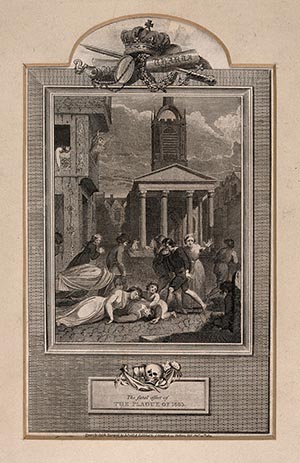
The plague in London, 1665. Etching by A Smith, 1810 (Wellcome Collection)
Sometimes, though, members of the College might sit an epidemic out within Univ. We know of one such case thanks to George Radcliffe, a Yorkshire gentleman whose letters home are the earliest such examples from a Univ undergraduate. On 29 June 1609, soon after arriving in Oxford, he wrote to his mother about a plague outbreak. In reading this extract, readers might imagine what George’s widowed mother felt on receiving such an insouciant account of what could have been a dangerous situation for her only son:
“As touching the state of our city, it is not so dangerous as may be the report with you. The plague hath been suspected to have been in the town, I confesse, and in two colleges, yet there died not above 6 in all, as far as I know … many were gone which are now returned, and many went rather out of a desire to go than feare to stay, for not only the University in general, but every colledge in particular, hath been so looked to, that there hath been little or no danger. The plague began a week or a fortnight before I came to Oxford, and then stayed till about the first Tuesday after I was come, and began then again: it ended about a fortnight or a week since: it was brought first by a Frenchman. There is no need that you should send a horse; for, if there should be any danger, I might be one and sell him when I come againe. My cousin Charles had sent me out of the town a great while ago, if I had desired it. He caused a pomander to be made for me by his direction, and another preservative to lay to my harte.”
Because of these various techniques, plagues tended to be more localised, and people were ruthless at keeping them so. During the Great Plague of London, the historian Antony Wood noted in his diary that on 1 July 1665 a watch was set in Oxford “to keepe out infected persons”. Any Londoner, ill or not, hoping to find refuge here would be told to go away. However, the greatest consequence of the Great Plague for Oxford was that in September, Charles II and his court moved here from Salisbury, as part of their attempts to avoid the plague, and Parliament met in Christ Church Hall in October. The king and his courtiers could not easily be forbidden entry. Charles II settled in Christ Church, and his queen in Merton – just like Charles I and Henrietta Maria in the 1640s – and the other courtiers settled where they could. So we know that that on 17 November John Earles, the Bishop of Salisbury died (not of the plague) when staying at Univ.
The court finally left Oxford in January 1666, and Antony Wood noted with relief that during this time “we had not the least shew of the infection of plauge among us.” Admittedly, he did grumble about the bad behaviour of the courtiers, and called them “rude, rough whoremongers.” But the presence of ill-mannered courtiers was surely less horrible than a plague outbreak.
The Spanish flu of 1918/19
The great influenza pandemic of 1918/19, known as the “Spanish Flu”, was the last major global pandemic before COVID-19. More than any previous pandemic, it ranged around the whole world, and is thought to have killed millions, including up to 250,000 people in Britain.
So how did the Spanish Flu affect Univ? It rather passed the College by. This may come as a surprise, but the College was in a rather strange position at this time. During the most dangerous phases of the pandemic, especially in the autumn of 1918, the College only had a tiny number of undergraduates resident, mainly students who were exempt from military service on medical grounds, and a handful of Fellows – everyone else was away on active service waging the First World War. This photo shows all six undergraduates resident in the College in the summer of 1918, along with the Classics Fellow, Dr A B Poynton.
Much of the rest of the College, especially Radcliffe Quad, had, as we will see in a later piece, been requisitioned as a military hospital. Student numbers within College only began to rise again in January 1919, by which time the flu virus had become less lethal.
As a result, there is no evidence of any student or Fellow resident in the College catching the flu, let along dying of it. It is possible that some of the soldiers in the parts of the College which had been turned into a hospital caught the flu, and even died from it, but the College holds no records about the hospital, since it was run by the government.
There remain those members of the College who were absent on active service. “We Will Remember Them”, James Miller’s major biographical register of our war dead, identifies just three men who are described as having died from illness in 1918, as opposed to being killed in action or dying of wounds. They might have caught the flu, but we cannot be sure.
It therefore does seem as if the Spanish Flu pandemic, as far as Univ was concerned, was like the dog which did not bark. Two years ago, a researcher wrote around all the Colleges to ask about the flu, and the pattern at Univ held true across the whole university – at least as regards the men’s Colleges. The women’s Colleges, of course, functioned normally throughout the war, even if some of them, like Somerville, had to move house as their sites were requisitioned. Sadly, therefore, there is evidence that some students from Lady Margaret Hall died from the flu.
Thus far, readers may think that Univ survived major past catastrophes surprisingly lightly. However, when we turn to the effects of war, some very different tales will emerge.
Univ: plague & war – part 2 will be published in due course.
Robin Darwall-Smith, Archivist
Published: 1 April 2020
Explore Univ on social media

